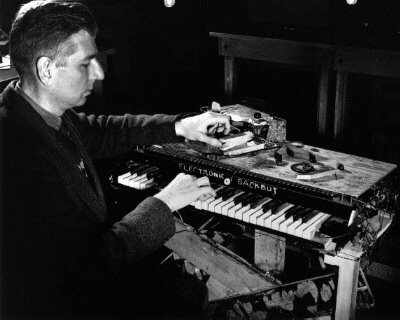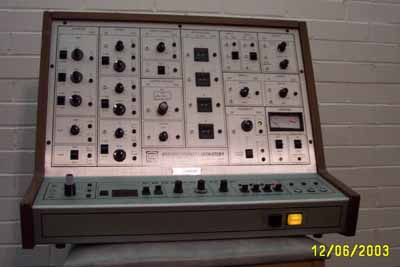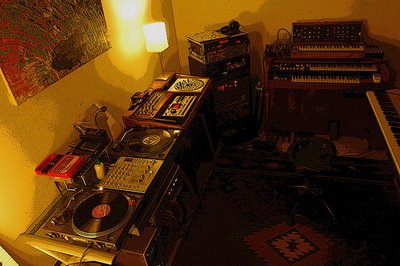
Tuesday, August 22, 2006
The Polyphone & Hugh Le Caine
 "The Polyphone (860004), an analogue polyphonic synthesizer, was built by Le Caine's National Research Council (NRC) lab in 1970, at the same time that the last two Sackbuts were being completed, and ten years before polyphonic synthesizers became commercially successful. Each key of its touch-sensitive keyboard had its own pitch control and wave form control. Essentially it was a bank of 37 key-operated oscillators, able to produce 37 separately defined tones.
"The Polyphone (860004), an analogue polyphonic synthesizer, was built by Le Caine's National Research Council (NRC) lab in 1970, at the same time that the last two Sackbuts were being completed, and ten years before polyphonic synthesizers became commercially successful. Each key of its touch-sensitive keyboard had its own pitch control and wave form control. Essentially it was a bank of 37 key-operated oscillators, able to produce 37 separately defined tones.Above the keyboard were several control devices that were typical of synthesizers at the time: low frequency oscillators, envelope generators, and filters, all of which could influence aspects of the overall sound produced by the instrument. Below the instrument was a pressure-sensitive pedal keyboard that controlled other aspects of the overall sound. The instrument provided extremely comprehensive resources and was potentially a very powerful tool; however, it was difficult to learn to play, a problem it shared with most synthesizers."
Title link takes you The Polyphone page on the Canada Science and Technology Museum website. Make sure to check out some of the other interesting bits while there.
 For more on Hugh Le Caine check out Hugh Le Caine.com. The following was pulled from the biography:
For more on Hugh Le Caine check out Hugh Le Caine.com. The following was pulled from the biography:"Canadian scientist and composer Hugh Le Caine (1914-1977) has been called one of the "heroes" of electronic music. He was brought up in Port Arthur (now Thunder Bay) in northwestern Ontario. At an early age he began building musical instruments and experimenting with electronic devices. In his youth he imagined "beautiful sounds" that he believed could be realized through new electronic inventions."
"At home he continued to pursue his interest in electronic music and sound generation. He established a personal studio in 1945, where he began to work independently on the design of electronic musical instruments such as the Electronic Sackbut, a sophisticated monophonic performance instrument now recognized as the first voltage-controlled synthesizer. Le Caine later developed voltage-control systems for a wide variety of applications."
"Perhaps the most important aspect of Le Caine's designs for his instruments was the "playability" that he took care to build into them. His fixation with "beautiful sound" led him repeatedly to design electronic instruments capable of producing a nuance-filled expression typical of the orchestral tradition. He had an acute sense of what performers needed if they were to be able to create the performance gestures that he believed formed the essence of music.
Touch sensitivity was an essential ingredient in this, and was used in keyboards, mixers, and other components, applied mechanically, electronically, and through light sensitivity. Le Caine's designs were so advanced in this respect that some of the features that he developed found their way into commercial designs only in the late 1980s."
 Image of Le Caine with the Sackbut.
Image of Le Caine with the Sackbut.via Frederic.
Update via slabman in the comments: "He did some pretty amazing stuff with the technology of the day - some of it still unmatched. For example, the Sackbut has a touch sensitive 2D timbral mixer control that balances various overtones & waveforms. Made the sound very controllable & dynamic, but also made the instrument more difficult to master. It's interesting to think of how there's a kind of Bell curve of synthesizer technology: one one end you have the laboratory instrument type approach (Buchla, Serge); at the other end, you have people inventing new instruments like the Sackbut & Theremin. Commercial gear mostly occupies the bump in the middle of the curve. It would be great to see some more activity at that 'new instrument' end."
The MAESTRO - Russian Poly Analog
 Title link takes you to shots pulled from this auction.
Title link takes you to shots pulled from this auction.Polyphony - 4 voices
Oscillators - 1
Preset sounds - 20 (sorted on category), registers 2',4',8',16'
Filter - 2-pole resonant lowpass 12dB/oct
Pitch - tuning, chorus
Modulation - vibrato depth, frequency
Amplifier - release, volume
Arpeggiator/tremolo - rate, up/down, single/double, note memory
Control - joystick pitch/modulation depth (X-Y)
Outs - line, phones(jack)
Weight - about 12kg
more on ruskeys
via frederic
Blevin Blectum
 Brian Comnes sent the following in after seeing this post on Women Take Back The Noise. The shots are of Blevin Blectum who is featured on the album.
Brian Comnes sent the following in after seeing this post on Women Take Back The Noise. The shots are of Blevin Blectum who is featured on the album. "Blevin Blectum, a local here is on it and here is a shot of her at last Year's SFEMF , there's a laptop running Live in 1 pizza box and I think a mixer in the other, the horse head is off the chart" Love the shoes as well.
Title link takes you to her site.

"I got this off of Blevin's site which also included a link to SFEMF archives with also some Zeena Parkins pictures -
see this link for more, actually there are some good shots of Zeena's harp , looks like guitar pickups on one side and some sort of ribbon controller on the other ..I don't see any MIDI output so I guess its just a harp"
"an as yet unreleased goody!" from Moog?
Someone in the comments of this post was surpised that no one caught a mention to "an unreleased goody!" from Moog Music in the following excerpt:
"Some time in November or December of 2004, Bob was introduced to Cyril Lance. As Winter NAMM was fast approaching, Bob kept telling me, 'I really want you to meet Cyril.' I just could not find the time until February, 2005. In the meantime, Bob had given Cyril a test project to work on (an as yet unreleased goody!). Needless to say Bob was very excited about what he saw – schematics, prototype, and (most importantly) thought process were all eerily similar to Bob’s way of working. Since then we have been truly blessed to have Cyril with us. He has poured his guts and all of his considerable brains into the Little Phatty; a project that would not have been possible without his efforts."
I completely missed this assuming that the reference was to the Little Phatty and the unreleased goody comment was a reflection of that point in time, but if that were the case it would have been worded differently [an unreleased goody at that point in time!]. Hmm... BTW, cheers to Cyril. Keep that torch burning.
"Some time in November or December of 2004, Bob was introduced to Cyril Lance. As Winter NAMM was fast approaching, Bob kept telling me, 'I really want you to meet Cyril.' I just could not find the time until February, 2005. In the meantime, Bob had given Cyril a test project to work on (an as yet unreleased goody!). Needless to say Bob was very excited about what he saw – schematics, prototype, and (most importantly) thought process were all eerily similar to Bob’s way of working. Since then we have been truly blessed to have Cyril with us. He has poured his guts and all of his considerable brains into the Little Phatty; a project that would not have been possible without his efforts."
I completely missed this assuming that the reference was to the Little Phatty and the unreleased goody comment was a reflection of that point in time, but if that were the case it would have been worded differently [an unreleased goody at that point in time!]. Hmm... BTW, cheers to Cyril. Keep that torch burning.
rekem1000 - Greatings from Australia
 rekem1000 sent me a greetings from Australia along with a link to his flickr set. Title link takes you there. There are some amazing shots in this set so do check it out. Thanks rekem1000! Man I love the color in this shot.
rekem1000 sent me a greetings from Australia along with a link to his flickr set. Title link takes you there. There are some amazing shots in this set so do check it out. Thanks rekem1000! Man I love the color in this shot.
Banana Frac Modular Progress - New Flickr Shot
Starkey Hearing Science Laboratory - New Flickr Shot
 flickr by zonkout.
flickr by zonkout."Four oscillators, three multimode filters, two A/R envelope generators, digital gate sequencer, noise generator, phase shifter, external audio input...but no CV control. Uses mini-banana jacks. Built in 1977."
Trip. Never seen one of these before.
Update via the comments: "Tres cool. This thing originally came with a set of speakers (follow the link and chech top left on the record cover). Although it isnt a real synt (it has no cv input) you can use it as a really cool gate/trig-processor and a trig sequencer. You can also make some strange noices 'manually' on it. Check this link."
Update via gerald in the comments: link to more shots pulled from this auction. Looks like it went for $541.
Women Take Back The Noise
 "The WOMEN TAKE BACK THE NOISE compilation, 3 years in the making, showcases a collection of 47 women artists worldwide who experiment with sound in various ways, ranging from ambient-organic to quirky-glitch-beat to harsh or extreme noise, as well as categories yet to be defined..."
"The WOMEN TAKE BACK THE NOISE compilation, 3 years in the making, showcases a collection of 47 women artists worldwide who experiment with sound in various ways, ranging from ambient-organic to quirky-glitch-beat to harsh or extreme noise, as well as categories yet to be defined..."Title link takes you there. Pretty cool.
PREVIOUS PAGE
NEXT PAGE
HOME













© Matrixsynth - All posts are presented here for informative, historical and educative purposes as applicable within fair use.
MATRIXSYNTH is supported by affiliate links that use cookies to track clickthroughs and sales. See the privacy policy for details.
MATRIXSYNTH - EVERYTHING SYNTH













© Matrixsynth - All posts are presented here for informative, historical and educative purposes as applicable within fair use.
MATRIXSYNTH is supported by affiliate links that use cookies to track clickthroughs and sales. See the privacy policy for details.
MATRIXSYNTH - EVERYTHING SYNTH






























